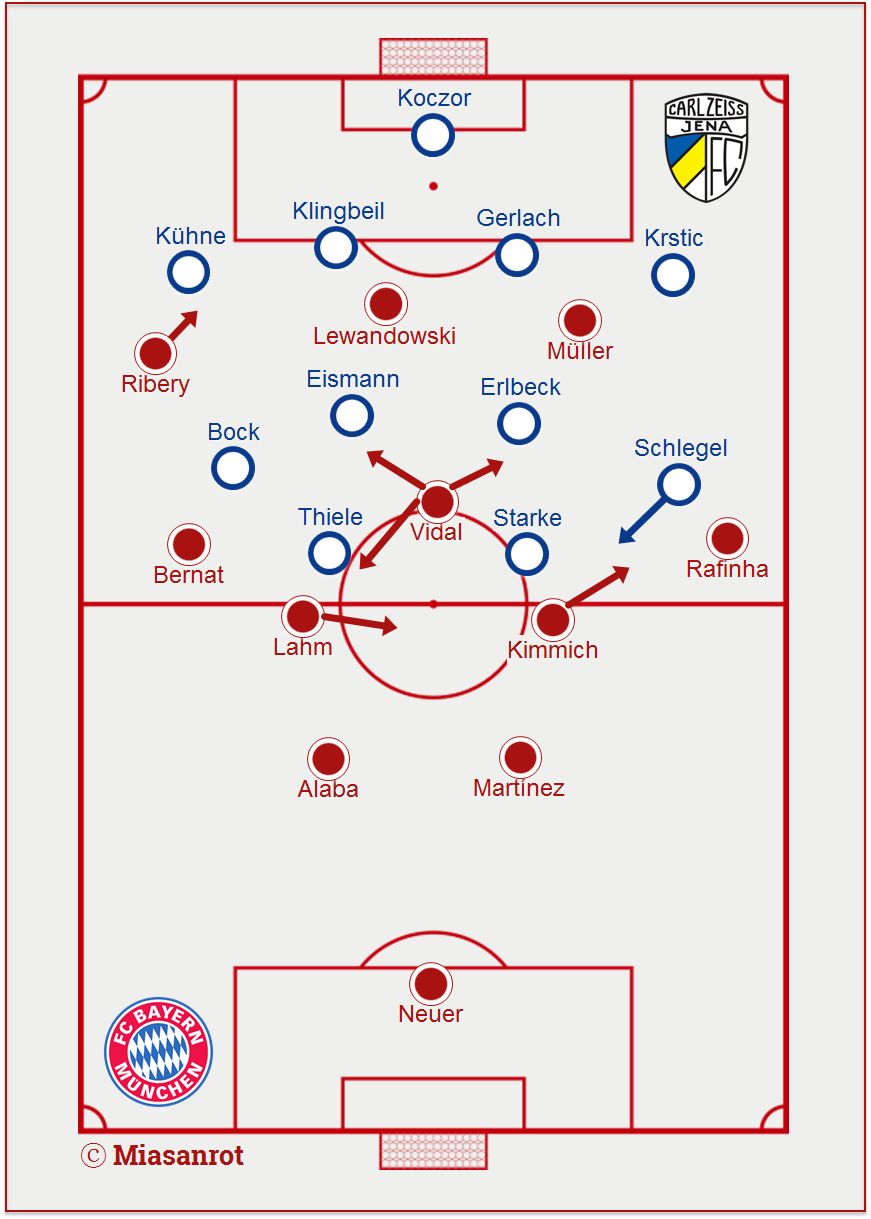Analysis: Carl Zeiss Jena – FC Bayern München 0:5 (0:3)
Preseason is over, it’s cup time for Bayern! On Friday, the record cup winners faced Carl Zeiss Jena in the first round of the DFB-Pokal.
In his first competitive match (unless you count the Supercup), Carlo Ancelotti already had to do without eight players, with Kingsley Coman being the latest addition to the injured list. Nevertheless, the starting eleven in Jena was a respectable and capable one.
 The starting lineups of the first-round match between Jena and Bayern.
The starting lineups of the first-round match between Jena and Bayern.3 things we noticed
1. The peculiar midfield three
Despite the new playing philosophy, controlling the midfield remains a key factor of the Bayern game. In Philipp Lahm, Joshua Kimmich and Arturo Vidal, the coach fielded a central midfield perfectly capable of achieving that. Their movement and positioning were rather flexible. Build-up tasks were mainly taken care of by the German internationals, with Vidal being more attacking-minded. However, this setup sometimes lacked verticality, as the midfield three was too deep or flat. Both the structure and the connections need to be improved in order to succeed against more skilled opponents. Bayern should feel more comfortable to use two attacking-minded midfielders against overly defensive teams, for example leaving only Lahm in a defensive role. Whenever they did that in Jena, it meant trouble for the hosts.
Kimmich in particular had a very respectable performance. Not only did he showcase his high football IQ, he was one of a few Bayern players (together with Ribery and Müller) who tried to build connections between defense and offense. In build-up, the 21-year-old usually shifted towards the right flank, in order to improve the positioning pattern. This was particularly effective whenever Jena decided to defend higher up the pitch. Furthermore, Kimmich disrupted the enemy lines with smart movement. All in all, Joshua Kimmich did well in a midfield role, even though Jena aren’t exactly the benchmark opponent. Still, he backed up his claim of preferring to play in midfield.
2. Roaming Ribery, convincing Müller
Franck Ribery appears to be the player who benefits the most from the new system. He’s his old creative self again, constantly looking for one-on-ones, taking advantage of spaces and building connections in the attacking third. The French winger was highly mobile and often showed up in central areas, sometimes even in deeper positions. The 32-year-old is Bayern’s most creative player at this point and involved in pretty much every attack. His constant roaming is a big boost to the still somewhat static Bayern game. The central midfield could’ve used a similar extent of mobility.
Thomas Müller too convinced with regular movement back into midfield. Whenever he moved between the lines in half spaces, Bayern’s attacks looked promising. Müller’s qualities in that regard are well known and as important as ever in the staring phase of the Ancelotti era.
3. Cautious Bayern – even in Jena
Even when facing a massive underdog, Bayern again acted more cautiously, limiting their pressing intensity. Ancelotti’s team still had a possession rate of around 70% but, every now and then, the opponent was allowed to keep the ball and attempt a controlled build-up. This caused some dangerous moments for the defense, proving that there’s still lots to improve. Bayern also have issues in the transitional offense. Counter-attacking opportunities are sometimes wasted and the gaps aren’t closed quickly enough.
In possession, Bayern attempt to act a lot more directly. Attacking a deep-lying defense with pace isn’t a bad idea but the lack of connections lead to far too many individual attempts with limited success rates. Jena offered tons of space for the attack, yet the positioning in the final third was far from ideal. It looked much improved whenever Bayern got into controlled possession moments.
There’s still a long way to go for Carlo Ancelotti, his staff and the players. Both structural and individual issues could lead to a tough opening phase in the Bundesliga. Some problems are to be expected with a new system and all that, the degree of defensive struggles however was a surprise. The conservative pressing gave Jena spaces to operate in – that it wasn’t punished was mainly down to the opponent’s lack of individual quality. The glimpses of the “old” aggressive pressing didn’t look as solid as it used to be. That being said, it was an ordinary cup match with the expected result. Bayern were the better team and won clearly. With some better aiming skills, they could’ve scored even more.
| FC CARL ZEISS JENA – FC BAYERN 0:5 (0:3) | |
|---|---|
| Carl Zeiss Jena | Koczor – Kühne (73. Zeqiri), Klingbeil, Gerlach, Krstic – Bock (56. Buval), Erlbeck, Eismann, Schlegel – Thiele, Starke |
| Subs | Schmidt, Mergel, Wolfram, Reimann, Cros |
| FC Bayern | Neuer – Rafinha, Martinez (51. Hummels), Alaba, Bernat – Vidal (77. Benko), Lahm, Kimmich – Müller, Lewandowski, Ribéry (66. Green) |
| Subs | Ulreich, Feldhahn, Dorsch, Öztürk |
| Goals | 0:1 Lewandowski (3.), 0:2 Lewandowski, 0:3 Lewandowski (44.), 0:4 Vidal (72.), 0:5 Hummels (77.) |
| Cards | Yellow: Kühne, Eismann / – |
| Referee | Harm Osmers (Hannover) |
| Attendance | 19.000 (ausverkauft) |




 August 19, 2016
August 19, 2016 


